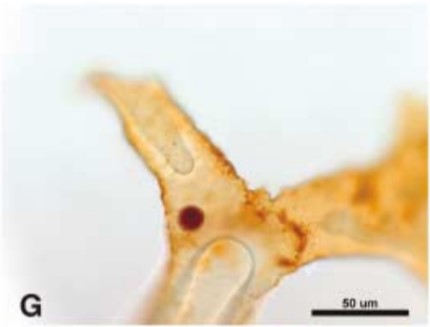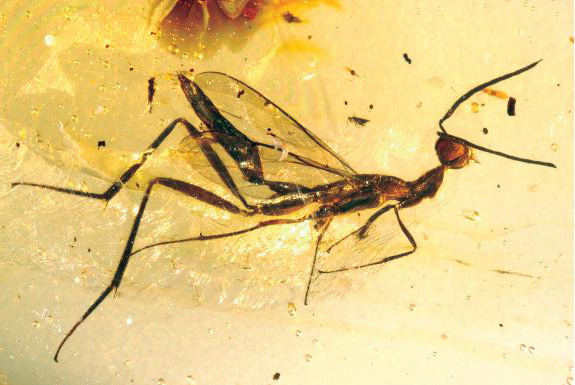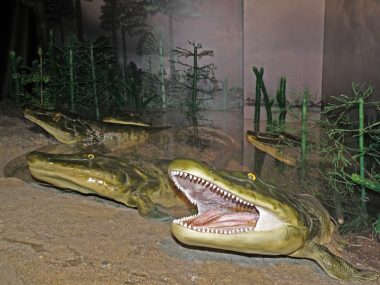Welcome to Jurassic Park
Have you ever wondered if dino DNA really exists in nature? (And if it does, should you worry about a real-life Jurassic Park fiasco?) What does original tissue in fossils mean for creationism? What does it mean for evolution? Maybe you’ve heard that evolution is disproved by the appearance of blood cells in fossils from Tyrannosaurus rex. Soft tissue is an amazing phenomenon in paleontology, and it is important to discuss the implications. Dr. Brain Thomas of ICR covers the basics and intricacies of original tissue in fossils in his 2013 paper, “A Review of Original Tissue Fossils and Their Age Implications.”
The following article is a summary of “A Review of Original Tissue Fossils and Their Age Implications” by Dr. Brian Thomas of ICR, and of the surrounding discussion and research pertaining to it. The views expressed do not necessarily reflect those of New Creation.
Million Year Old Molecules?
What comes to mind when you think of a fossil? Probably a dinosaur bone or skeleton, right? Typically, when a bone becomes a fossil, it has been buried and mineralized, changed by natural processes into, essentially, a hard rock. Rather than containing blood vessels, cartilage, nerves, and DNA (which all break down over time), a typical fossil usually consists of the minerals which replaced the original tissue. In fact, researchers believed for a long time that original tissue could not exist at all in old fossils due to the natural breakdown of organic molecules. Recent years have yielded incredible discoveries of several types of original tissues, from all over the world, in dozens of animals.

In 2005, Mary Schweitzer published the shocking presence of soft tissue in T. rex material1 and, thanks to rigorous testing by her lab and other researchers, defended the claim. Researchers employed several techniques to determine the presence of soft tissue in fossils dated as millions of years old, and it is controversial research. In the context of deep time, the main question surrounding original tissue is this: how do organic molecules survive for millions of years without being eaten, oxidized, hydrolyzed, or kerogenized? Regardless of deep time, how long can molecules last?
The Study of Collagen


Researchers have conducted studies over the years to answer these questions for various biomolecules. One such molecule, collagen, is a great candidate for study, as it is typically protected from oxygen within bones and it is not soluble in water. Therefore, if collagen cannot last, nothing else should either.
Recent studies calculated the “shelf life” of collagen by using mass spectrometry on fresh bone. The results estimated a half life of 130,000 years at a temperature of 7.5°C. Another study took a look at Ice Age fossils, calculating that practically all collagen decays between 200-700,000 years at 10°C. These studies are accounting for optimal burial conditions. In other words, the fossils must be protected from outside elements as much as possible to last a maximum amount of time. What does this mean for a T. rex which would be conventionally dated at 66-67 million years old? Well, at a constant temperature of 7.5°C, a seven ton T. rex would have no identifiable collagen left after 1.7 million years. This is a problem for deep time.
DNA

What about DNA? Surely this massive molecule could last a while, right? Unfortunately, DNA is extremely vulnerable to chemical reactions from water, heat, and oxygen exposure. It easily breaks down in the presence of these, and the “time to dust” is about 10,000 years. Can we find it at all, then? Yes! DNA has been found in several fossils, including bacteria, Ice Age moas, dinosaurs, and Neanderthals. Though Cretaceous dino DNA was originally questioned as contamination, studies from Schweitzer verified its presence in dinosaur bone cells. This is remarkable preservation! Additionally, the allegedly 40,000 year old Neanderthal DNA has been almost entirely sequenced. What about DNA in amber, Jurassic Park style? You bet! Though amber is not tough against all exposure (due to cracking and exposure to elements), DNA can be found within resinite fossils.
What about Carbon-14?
Soft tissue isn’t expected to last more than several thousand years, but do other dating methods support this? The half-life of carbon is such that it should not be present in rocks or fossils for longer than 90,000 years. However, it has been found several times in samples normally dated as millions of years old. Mosasaur and Allosaurus material, for example, have been found to contain Carbon-14, though conventionally are thought to have been around tens of millions of years ago. The usual explanation for these types of scenarios is that there was contamination of samples. More studies should be done on these situations in order to define the true source of Carbon-14.
Explaining the Data
What does it all mean? Sensitive biomolecules such as collagen and DNA should last no longer than a few hundred thousand years. In a conventional model, finding soft tissues such as these in dinosaurs should be impossible, yet the evidence stands. So what are the explanations for the presence of the impossible?
A Requirement for Preservation
The first requirement for the presence of soft tissue is a best case scenario preservation: rapid burial, with water draining soon after to prevent breakdown. Anoxia has been experimentally proven to NOT prevent decay, so this is not a requirement. Heat would be valuable in sterilizing the organism from microbes, but humidity is not ideal as it can increase decay and microbial action.
Explanations for Preservation
The second suggestion is that biomolecules may undergo “mineral sequestering” in which functional groups of molecules bond with bioapatite. This is an interesting theory, but it has not been tested and needs more work. One problem with the theory is the preservation of some parts of the molecules whereas other parts decay as normal. Why is there such a bias present? Future studies would be very helpful in understanding if there is an actual mechanism for this theory.
Lastly, some suggest a bacterial biofilm as an explanation for soft tissue. Perhaps the soft tissues found are not truly original tissues! Well, this suggestion does not hold up to immunological experiments or the complex morphological evidence found in many soft tissues.
The Creationist Take Away
![By Wilson44691 at English Wikipedia - Photograph taken by Mark A. Wilson (Department of Geology, The College of Wooster).[1], Public Domain, https://commons.wikimedia.org/w/index.php?curid=3797915](https://newcreation.blog/wp-content/uploads/2021/06/Aviculopecten_subcardiformis01-1024x1022.jpg)
What should creationists take away from this? Firstly, Dr. Thomas cautions readers to be careful of phrases like “remarkable preservation,” as there can be many meanings for this. “Good preservation” can range from a well preserved outline of a fossil (or an imprint as seen to the left) to containing DNA. If you read this phrase in a news report or scientific article, check out the details so you don’t misinterpret the findings. Secondly, he notes the limits on creation research as many paleontological studies do not report or analyze the chemistry of the fossil. There is a lack of experimental work on soft tissue, and this is preventing further creation studies from gleaning information from the literature. Lastly, he emphasizes that research, whether secular or not, is valuable to understanding soft tissues and their longevity. We should not overlook studies on decay rates as they come out.
Conclusions
The presence of biomolecules in many fossils does not coincide well with the conventional ages of the geologic record. Creationism, with its short timeframe, can more easily explain the findings than evolutionary frameworks. However, creationists should not proclaim that evolution is disproved! This would not be an accurate statement or an appropriate representation of the current data. Many challenges persist when it comes to the preservation of fossils and soft tissue. We should value and heed any future studies. And, more people should join in on the research!
Footnotes
- Schweitzer, M. H., et al. (2005). “Soft-Tissue Vessels and Cellular Preservation in Tyrannosaurus rex.” science 307(5717): 1952-1955. ↩︎












“There is a lack of experimental work on soft tissue,”
Evolutionists must be terrified by the stuff 🤪😳😵
It says it all that time Bob Enyart called Jack Horner to offer paying for c14 testing on Schweitzer’s Trex bone
Hi there,
One reason the experimental work has been lacking is due to the assumption that soft tissue in these kinds of fossils would not even exist (due to their proposed age)! But it’s exciting to see that it does, and it is more common than conventional science would think!
Noel
Dr Mark Armitage has done and is doing an immense amount of research on soft tissue , is there any reason why his research is not included here as well .
Hi Alan,
This is not an original article. Rather it is a summary of Brian Thomas’ article on the topic. If you read Thomas’ original article, you will see that he cites Mark Armitage in his research.
Thankyou
The Science